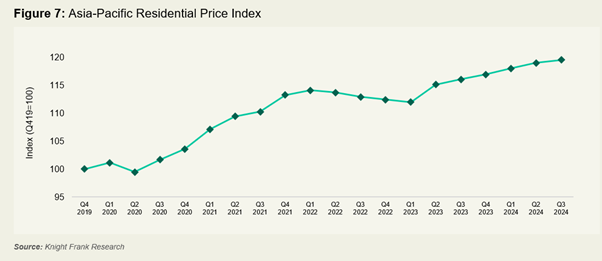Vietnam: A Fast-Emerging Luxury Market
The Asia-Pacific region has emerged as a vibrant landscape for real estate investment, attracting local and foreign investors.
3 minutes to read
This interest is driven by a combination of favourable ownership regulations, economic growth, and demographic trends that enhance the appeal of various markets. Countries such as Vietnam, Australia, and Japan are at the forefront of this trend, offering unique lifestyle benefits alongside lucrative property price appreciations.

Vietnam's residential property market, particularly in Ho Chi Minh City (HCMC) and Hanoi, has captured the attention of HNWIs due to several factors. The average selling price for high-end apartments in the country, ranging from US$5,400 per square meter (psm) to US$15,000 psm for ultra-luxury properties, is on par with global developed markets. The allure stems from Vietnam's rapid economic growth, which not only drives demand for real estate but also promises capital appreciation. This combination makes the country an attractive investment destination, as its real estate market is primed for long-term growth and offers significant potential returns.
Government reforms have played a pivotal role in easing foreign property ownership regulations and creating a more investor-friendly environment. Vietnam's strategic location in Southeast Asia positions it as a regional business hub, and its emergence as a 'China+1' destination has attracted a growing expatriate population, including young professionals and families, boosting the appeal for international investors. This aligns with broader cross-border trends, where affluent buyers from Asia seek luxury properties in emerging markets with high rental yields and strong growth potential. The influx of MNCs, such as Apple and Intel, setting up offices in HCMC further boosts rental demand for luxury residential properties, driven by the needs of international professionals taking up senior roles.
Infrastructure development is another critical factor shaping the outlook for Vietnam’s property market. The expansion of highways, metro systems, and airports improves connectivity and accessibility, enhancing property values in emerging urban areas. These developments, coupled with government incentives for foreign buyers, will likely sustain Vietnam’s attractiveness as a prime destination for HNWIs seeking diversification and long-term growth.
District 1 in HCMC, provides unparalleled access to corporate offices, commercial hubs, and cultural attractions, making it a hotspot for both local and international investors. District 2, on the other hand, known for its peaceful riverside views and international schools, has become popular among families and expatriates. Infrastructure improvements, including the upcoming metro system, have significantly boosted District 2’s appeal. Post-pandemic, a growing demand for larger living spaces has been pushing District 2 into the spotlight. The shift toward hybrid work models has spurred demand for homes with amenities like study rooms and gyms. On the rental front, flexible lease terms and incentives are now more common, contrasting with the pre-pandemic market, which had higher demand and less flexibility.
Buyer profiles and nationalities
Vietnam's high-end real estate market has shown resilience post-pandemic, attracting overseas Vietnamese (Viet Kieu) and international investors from countries like South Korea, Japan, and the Chinese mainland. Many Viet Kieu are motivated by family ties, while international buyers are drawn to Vietnam’s economic growth and potential for price appreciation. The diverse buyer pool underscores Vietnam’s appeal as both a lifestyle and investment destination.
Urban areas like HCMC and Hanoi are favoured by those seeking proximity to business hubs and vibrant social experiences. In contrast, resort locations such as Nha Trang and Da Nang attract buyers looking for a laid-back and coastal lifestyle. Foreign investors are increasingly targeting these resort cities, attracted by the potential for vacation rental income and scenic beauty.
For more insights, please download the latest edition of Knight Frank’s Asia-Pacific Horizon series, Quality Life-ing: Mapping Prime Residential Hotspots, report below.